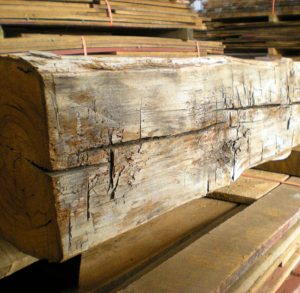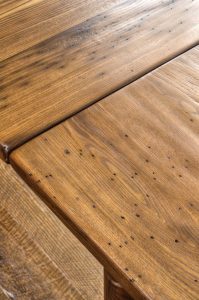History of Reclaimed Wood
Reclaimed and Repurposed
Reclaimed wood is not new, unstable, uniform, generic or cheap. It’s not the latest trend or the quickest fix. When people say “reclaimed wood” they’re referring to aged, recycled timbers: wood that was harvested decades ago, used in construction, and then salvaged when its original building was torn down. Sometimes this reclaimed lumber is left mostly intact, such as in large, hand-hewn reclaimed beams. Other times it’s re-milled and used for a new purpose, such as when an old joist (that’s a horizontal supporting member) is sawn into planks to create reclaimed flooring.
The Unique Story of Reclaimed Wood
The history of these woods is influenced by the handlers and loggers who found a way to extract the trees, get them down a rail line or river to a sawmill, and then on to feed the growth of a voracious county. Each piece of wood has its own history and story to tell, and most old-growth wood is no longer available. Thus the infatuation with reclaimed and antique woods – no one else will have what you have!
A New Tradition
For the past 30 years, a trend of carefully “deconstructing” buildings—taking them apart piece by piece, rather than just knocking them down or blowing them up—has been taking hold. This is the reclaimed wood process and it is gaining in popularity.
Eco-friendly Wood Sourcing
There are obvious environmental benefits to repurposing otherwise fine pine, oak, hickory, and teak. The trees that these woods came from are long felled, the result is cured to perfection and it often takes minimal treatment to be used in a design. Reclaimed wood flooring from a warehouse will retain the original scrapes and scratches even after sanding, making this an easy way to provide a design element with minimal work.
Unique Qualities of Reclaimed Wood
 Reclaimed wood is usually of a quality you can’t find in stores today. Recycled lumber and reclaimed wood originate from original stands of old-growth forests. Much of this recycled wood dates back prior to modern construction and milling methods. Before World War II, mature trees that had grown slowly over hundreds of years were commonly used in construction. Reclaimed timber that originated with these ancient trees is stronger and has denser growth rings than the younger wood being taken to mills today.
Reclaimed wood is usually of a quality you can’t find in stores today. Recycled lumber and reclaimed wood originate from original stands of old-growth forests. Much of this recycled wood dates back prior to modern construction and milling methods. Before World War II, mature trees that had grown slowly over hundreds of years were commonly used in construction. Reclaimed timber that originated with these ancient trees is stronger and has denser growth rings than the younger wood being taken to mills today.
The character of Old Growth Wood
The beams and planks created from these massive trees are larger and wider than modern lumber. It would be extremely expensive to recreate the size of some of these pieces, and of course, the quality of antique wood cannot be replicated in newer growth years. Antique wood is unrivaled in terms of its beauty and coloration due to the natural aging process. As the wood dries and ages, the oxidation occurring on the surface creates the patina, which is very difficult to recreate in new lumber.
Reclaimed and antique wood is growing in popularity and helping to preserve tidbits of our history that can continue to be admired and enjoyed well into the future.
Come and visit us at Shenandoah Kitchen & Home to view our reclaimed wood furniture. Each piece has its own history and story, steeped in Loudoun County Virginia history. We invite you to come to our location in downtown, historic Purcellville to meet our craftsman and choose the reclaimed wood furniture that will become part of your family history.






